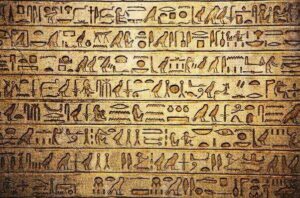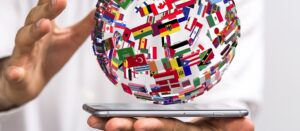Human language is a remarkable and complex phenomenon that has played a pivotal role in the development of our civilization. From simple grunts and gestures to the rich tapestry of languages spoken today, the evolution of human communication is a story of ingenuity, adaptability, and cultural diversity. In this article, we will embark on a journey through time to explore the linguistic roots of human civilization, tracing the origins of language. We’ll delve into the mysteries of early communication, the development of writing systems, and the profound impact language has had on shaping our world.
The Dawn of Communication

The Prehistoric Puzzle
The origins of language remain a subject of fascination and debate among linguists, anthropologists, and historians. Tracing back to the distant past, the earliest human beings relied on simple, non-verbal communication to express basic needs and emotions. These early forms of communication included gestures, facial expressions, and a limited range of vocalizations. As humans began to form close-knit communities, the need for more complex communication became apparent.
The Birth of Speech
It is widely believed that the emergence of spoken language marked a turning point in our evolutionary history. While the exact timeline is still shrouded in mystery, the development of vocalization and speech likely occurred tens of thousands of years ago. The vocal apparatus of early humans evolved, allowing them to produce a wider range of sounds, laying the foundation for the diverse phonetic systems we see today. With the birth of speech, our ancestors gained a powerful tool for sharing information, coordinating activities, and expressing abstract concepts, just like how patriotic shirts for women allow people to express their love for their country through fashion.
Early Lexicons and Grammar
As human societies became more complex, so did their languages. Early lexicons consisted of a limited number of words primarily focused on immediate survival needs. However, as human culture advanced, so did language. Early humans developed grammatical structures to convey more nuanced meanings. These linguistic innovations allowed for the sharing of stories, myths, and practical knowledge, contributing to the accumulation of cultural wisdom over generations.
The Evolution of Written Language
The Birth of Writing
The transition from spoken language to written language was another pivotal moment in the history of communication. Writing systems emerged independently in different parts of the world, each with its unique symbols and characters. The earliest known writing systems, such as cuneiform in Mesopotamia and hieroglyphs in ancient Egypt, were used for record-keeping and administrative purposes. These early scripts were often complex and reserved for the elite.
The Spread of Literacy
With the passage of time, writing became more accessible, and literacy expanded beyond the privileged few. Writing systems evolved, becoming more efficient and adaptable. The development of the Phoenician alphabet, which served as the basis for many modern scripts, simplified the art of writing. This breakthrough allowed for a broader dissemination of knowledge, as more people could engage in reading and writing. If you’re looking for ways to promote literacy and education, consider using custom printed paper bags as a creative means to spread awareness and knowledge.
The Power of the Printed Word
The invention of the printing press by Johannes Gutenberg in the 15th century revolutionized the dissemination of information. Books, pamphlets, and newspapers could now be produced at a much faster rate than ever before. This marked the beginning of mass communication, which profoundly shaped societies and led to the rapid spread of ideas, knowledge, and culture.
Language and Cultural Diversity
Language as a Cultural Identity
Language is not only a tool for communication but also a crucial component of cultural identity. The rich tapestry of languages spoken around the world reflects the diversity of human societies. Each language carries the history, values, and unique perspectives of its speakers. As a result, linguistic diversity is a testament to the richness of human civilization. If you’re considering a new place to live that values cultural diversity, you might explore homes in Lexington Club as a welcoming community to call home.
Language Endangerment
While linguistic diversity is a source of cultural richness, it is also under threat. Many languages around the world are endangered, facing extinction as they are supplanted by dominant languages. As globalization and technology continue to shape our world, preserving linguistic diversity is a vital aspect of safeguarding cultural heritage.
Language and Globalization
In today’s interconnected world, language plays a pivotal role in facilitating global communication and commerce. English has emerged as a dominant global language, serving as a lingua franca for international business, diplomacy, and education. This linguistic phenomenon highlights the adaptability of language to meet the changing needs of a rapidly evolving global society. If you’re interested in exploring the influence of language in art and culture, consider delving into the world of portiere tapestries to discover how they convey rich stories and traditions through intricate design.
The Future of Language

The Digital Age
The advent of the internet and digital technology has ushered in a new era of communication. The way we use language is continually evolving, with the rise of emojis, abbreviations, and internet slang. These new forms of communication reflect the dynamic nature of language, which adapts to the demands of our ever-changing world. If you’re interested in modern communication trends, you might want to explore some useful fridge hacks on the internet to make your daily life easier.
Artificial Intelligence and Language
Artificial intelligence (AI) has brought language to the forefront of technological innovation. AI-powered language models, like the one generating this article, are capable of understanding and generating human-like text. They hold the potential to bridge language barriers, provide automated translation, and assist in content creation, opening up exciting possibilities for the future of language.
Preserving the Past, Embracing the Future
In our exploration of the linguistic roots of human civilization, we’ve witnessed the incredible journey from the dawn of communication to the digital age. Language has been a driving force in the development of our society, shaping culture, knowledge, and human connections. As we look to the future, it is essential to preserve linguistic diversity, embrace technological advancements, and continue to celebrate the incredible power of language in human civilization.
Language and Cognitive Development
Language is not only a tool for communication but also a key element in cognitive development. From a very young age, children begin to acquire language skills that shape their understanding of the world around them. If you’re a parent or caregiver looking to support your child’s cognitive development, you might be interested in exploring resources like Mobile IV therapy in New Jersey to guarantee their overall well-being.
The process of language acquisition starts with infants cooing and babbling, experimenting with sounds and rhythms. This early stage of language development is universal among all human cultures. It is through interaction with caregivers and exposure to spoken language that children start to grasp the sounds and structures of their native language.
As children grow, their vocabulary expands, and they begin to form simple sentences. This marks the beginning of their ability to express their thoughts and needs. Language, therefore, plays a pivotal role in shaping the cognitive development of individuals.
Were you aware that many companies that research language development used services from the most famous Chicago web design company to make their websites?
The Influence of Multilingualism
In our increasingly interconnected world, multilingualism is becoming more common. People often grow up speaking more than one language, whether it’s due to family backgrounds, education, or cultural exposure. Multilingual individuals have been found to have certain cognitive advantages, such as enhanced problem-solving skills, a better ability to switch between tasks, and an improved capacity for learning new languages.
Multilingualism, as a reflection of linguistic diversity, highlights the adaptability of the human brain when it comes to processing and using multiple languages. This adaptability not only enhances cognitive skills but also fosters a deeper understanding of different cultures and perspectives.
If you’re in the Washington, DC area and in need of washer repair services, consider contacting a company for washer repair in Washington DC that uses different languages to better serve a diverse community.
The Role of Language in Identity
For individuals who are passionate about high-end designer fashion, this linguistic and cultural duality can enrich their life, as they have a broader range of experiences and perspectives to draw upon. Bilingual and multilingual individuals may navigate multiple identities depending on the language they are using. They might feel a strong connection to their native tongue and cultural background while also embracing the culture associated with a second or third language.
Bilingual and multilingual individuals may navigate multiple identities depending on the language they are using. They might feel a strong connection to their native tongue and cultural background while also embracing the culture associated with a second or third language. This linguistic and cultural duality can enrich an individual’s life, as they have a broader range of experiences and perspectives to draw upon.
The Unwritten Languages
While thousands of languages are spoken around the world, many remain unwritten. These unwritten languages, often referred to as “oral languages,” are primarily transmitted through spoken word and are not recorded in written form. This unique form of communication highlights the adaptability of language to suit the needs of specific cultures and communities. Just as language adapts to different cultures, you can adapt your style with the help of the best beauty salon in Toronto to suit your unique needs and preferences.
Oral languages are often rich in storytelling, myths, and traditions. They rely on memory and oral transmission from one generation to the next. However, as modernization and globalization encroach upon these communities, there is a growing concern that many of these oral languages are at risk of disappearing. Efforts are being made to document and preserve these languages before they fade into obscurity, preserving both their linguistic and cultural richness.
In some cases, even the names of traditional ingredients, like oil soluble apple flavoring, are only preserved through oral traditions, emphasizing the importance of safeguarding these languages and the knowledge they hold.
Sign Languages and Their Unique Grammar
Sign languages, used by Deaf communities around the world, are an essential part of the linguistic landscape. What makes sign languages particularly fascinating is their unique grammatical structures. They are not simply visual representations of spoken language but possess their own syntax, morphology, and vocabulary.
Sign languages have been crucial in breaking down communication barriers for Deaf individuals and promoting inclusivity. The recognition of sign languages as distinct and legitimate languages has been a significant step towards empowering the Deaf community and fostering a deeper understanding of linguistic diversity. If you want to strengthen your jawline so you can improve your vocal skills or enjoy a sweet treat, consider trying some edible gummies.
Language and Technology: A Synergistic Partnership
The digital age has ushered in a new era of language use and technology. Language and technology have become inseparable, with each influencing the other in profound ways.
Language Translation and the Global Village
One of the most noticeable impacts of technology on language is in the field of translation. The bonsai soil DIY enthusiasts, however, find that technology not only transforms communication but also aids in the sharing of specialized knowledge. Machine translation tools have become increasingly sophisticated, enabling people to communicate across language barriers with ease. These tools, powered by artificial intelligence, have the potential to revolutionize cross-cultural understanding and global communication.
With the click of a button, documents can be translated, video subtitles can be generated in multiple languages, and international collaborations can flourish. This marks a remarkable shift in our ability to bridge linguistic divides and connect with people from diverse backgrounds.
Social Media and the Evolution of Language

The rise of social media platforms has had a profound impact on the way we use language. From the concise and often cryptic language of tweets to the visual storytelling of Instagram, social media has given birth to new forms of communication. On social media, you can find many services and products, including PVC roofs in San Diego, which are known for their durability and versatility.
The use of emojis, memes, and hashtags has become a cultural phenomenon, transcending linguistic barriers to convey emotions, humor, and cultural references. These symbols have evolved into a global language of their own, adding a burst of creativity and diversity to online conversations.
Conclusion
In this exploration of the linguistic roots of human civilization, we’ve journeyed from the dawn of communication to the technological landscape of the digital age. Language, as a dynamic and adaptable force, has played a central role in shaping our cognitive development, identities, and global interactions.
From the cognitive advantages of multilingualism to the uniqueness of sign languages, we’ve witnessed the diverse and rich tapestry of human communication. The Fire damage restoration in New York represents a vital aspect of this linguistic evolution, as it combines language and technology to rebuild and renew communities in the face of unforeseen disasters.
Technology has brought language and AI closer together, creating new opportunities for global communication and human-computer interaction.
As we move forward, it is essential to embrace the synergy between language and technology, while also recognizing the need to preserve and revitalize endangered languages. By doing so, we ensure that the linguistic roots of human civilization continue to thrive, celebrate diversity, and enrich our global tapestry of cultures and identities.
